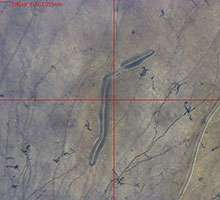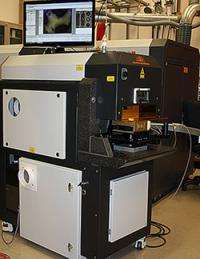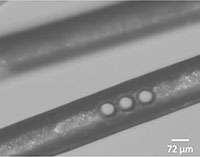Laser technique expands capabilities: New system will advance carbon cycling and alternative energy research

Using short pulses from an ultraviolet laser, scientists are able to fracture organic samples that can be measured to produce a stable-isotope ratio. This ratio has applications in forensics and medicine, but also can be used to better understand metabolic processes in microbes.
"The ability to hit an organic material with a laser – what we call ablate - and have particles break off with a composition isotopicly and molecularly representative of the sample is very exciting," said EMSL Senior Research Scientist Lizabeth Alexander.
A new research technique combines laser ablation with mass spectrometry for isotopic analysis. It's part of a much larger research effort at EMSL, a national scientific user facility.
A new EMSL user capability
A joint EMSL and Pacific Northwest National Laboratory team is currently focused on creating a laser ablation and absorption-based system to analyze minute quantities of biological samples. This new study began at EMSL in April 2011.
The team's new system uses a state-of-the-art UV laser capable of two-micron resolution. EMSL researchers are working with the manufacturer to push it down to one-micron resolution. The ultimate goal is to develop a system capable of submicron sampling for microbial and cellular-level research.
To analyze micron- or submicron-sized samples, the team is using a capillary laser-absorption spectrometer developed by PNNL scientists capable of detecting picomoles of carbon, which is the size needed to study a cluster of organisms within a microbial community.
"The capillary absorption system is in orders magnitude better as far as sample size than any other instrument available," said team member and EMSL Staff Engineer Matt Newburn.
One of the first uses of this new system will be to examine the distribution of microbes in soils. The team members want to study the way nutrients move within microbial communities. They are particularly interested in how the carbon cycle works in the soil on the micro-pore scale.
"We want to study a little tiny soil aggregate with a lot of micro structures," said Alexander. "It's believed this is where microbes live and where the real action happens when they digest organic matter and produce and take up carbon in the atmosphere."
This new technology also could be used for alternative energy research. Scientists will be able to study how the microbes in a termite's gut efficiently turn cellulose into glucose. This information could be useful in clean energy development, such as biomass research. Another use of laser ablation capillary spectrometry is medical diagnostics. Doctors use isotopes to label certain biological processes. Being able to track those isotopes on a very small scale, in real time and in vivo could prove useful.

The new laser ablation capillary absorption instrument is still in the testing phase, but should be available to EMSL users in early 2013.
"When we're done, EMSL will have a state-of-the-art laser ablation capillary absorption instrument that will be one of kind in the world," said Alexander.
Watch the iDirector video on EMSL's YouTube channel of Alexander talking about her research.
A brief history of laser ablation mass spectrometry
In 2005, PNNL Scientist Helen Kreuzer proposed expanding laser ablation and mass spectrometry technology at EMSL with the goal of developing a process to conduct isotopic research on microbial communities. She approached both Alexander and Newburn to be a part of the study because of their extensive experience with laser ablation and mass spectrometry.
When the study began, the available commercial UV laser ablation systems had a resolution between 25-50 microns. The research team applied ultraviolet laser ablation to organic samples, such as polymers, and biological materials, such as hair.
The team analyzed ablated particles using EMSL's high-resolution time-of-flight aerosol mass spectrometer. The scientists found the ablated sample particle size distribution was between 100-200 nanometers – the ideal size for other analysis instruments. The high-resolution time-of-flight aerosol mass spectrometer also demonstrated the samples' molecular signature was largely preserved and could be used to rapidly characterize the larger sample.
"One of our laser ablation findings is now an industry standard," said Alexander. "If you laser ablate in the ultraviolet range with a very short pulse, you get a much smaller and narrower particle size distribution than you do with the longer wavelength from an infrared laser. You put all the energy into the sample so fast; there is no time for it to vaporize, so it fractures like a mini explosion."

The team started its analysis with organic polymers using an isotope ratio mass spectrometer, or IRMS. The test samples included a synthetic material called Delrin®, as well as blue and clear fishing lines. They chose these samples because they were simple chemically and homogenous.
"We used materials we knew were homogenous over the whole sample," said Alexander. "In conventional IRMS analysis you have to use much larger samples to make it work. If it wasn't homogenous, you would see deviations."
The team also used horse and human hair to test potential forensic applications. The scientists were trying to show laser ablation is capable of detecting spatial variations of isotopes along the individual hairs by taking samples along the hair shaft. The team was able to take six individual measurements on one-day's growth of human hair and 12 individual samples on one-day growth of horse hair.
"The forensic work was to see if you could analyze samples from a strand of hair and be able tell where the donor was or ate at a particular time," said Newburn.
The results from this study, featured in Rapid Communications in Mass Spectrometry, were part of the due diligence to show laser ablation could be successfully combined with mass spectrometry for isotopic analysis.
Laser ablation is done at normal atmospheric pressure, unlike most other mass spectrometer sampling techniques conducted in a vacuum. This means researchers are able to test samples in vivo, or using a whole living organism.
Small sample size is one of the major advantages of the team's laser ablation mass spectrometry technique. The team demonstrated that it could use minute quantities of samples and get accurate results. The use of laser ablation also means little or no sample preparation is required before running the analysis.
The team's new laser ablation capillary absorption capability provides all the advantages of the earlier laser ablation mass spectrometry process, but at a more enhanced level, including the use of exceedingly small biological samples, minimal sample preparation, extreme spatial differentiation and in vivo testing.
"One of the missions of our funding is to come up with technologies to study microbial communities," said Alexander. "We're getting close. We've developed a laser ablation system able to probe very small samples. We haven't tested microbes, but we will soon."
Provided by Environmental Molecular Sciences Laboratory




















